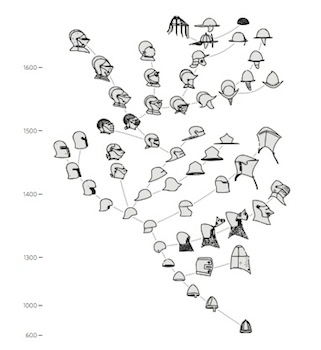What Technology Wants
Understanding the whole system
I’m breaking all the rules of Cool Tools here. I am going to review my own book, and it is not 100% toolish. But the book does have a lot to do with technology, and some readers may find it personally useful in helping them decide what kind technology to embrace. I promise to unleash this kind of self-promotion only once every ten years, so I’ll keep it interesting.
My book, What Technology Wants, presents an unconventional view of technology. I inspect the world through the eyes of technology as if it were an autonomous system. Here are some provocative things I see through its point of view:
* Technology is the most powerful force on the planet.
* Technology is an extension of evolutionary life, best thought of as the 7th kingdom of life.
* Humanity is our first technology; We are tools.
* Technology is selfish; as a system it exhibits its own urges and tendencies.
* Technologies cannot be banned, and none go extinct.
* The progression of technologies is inevitable.
* Because technologies are inevitable we can prepare to optimize their benefits.
* Technology is not neutral but serves as an overwhelming positive force in human culture.
* We have a moral obligation to increase technology because it increases opportunities.
* The origins of technology lie in the Big Bang.
* Technology preceded humans and will continue beyond us.
* Among the things technology wants are increased diversity, complexity, and beauty.
* Technology may be as much a reflection of the divine as nature is.
* Technology is an infinite game, a grand story we can align ourselves with for greater meaning.
What I learned from writing this book is that I want to minimize the amount of technology in my own life while maximizing it for others. I want the largest pool of choices possible so that I can select a minimal set of highly-evolved tools that will optimize my gifts. At the same time I have a moral obligation to maximize the amount of technologies in the world at large so that others may also select their minimal set from this ever growing pool of possibilities.
I hope what you get from reading What Technology Wants is a useful framework for understanding what technology means in our lives — a way to anchor your own self in the face of ceaseless accelerating technological change.
(I think of this book as the second part of a conversation that began with my research postings in The Technium. I’ve taken those rough posts, improved by readers’ comments, thrown out half of the material, and then refined the best into a readable book much better than the blog. I’ve set up some forums for discussions, and a Facebook page where you can “like” it. I’ll be on the road speaking about the book in October, November and January. My schedule and more can be found at the book’s webpage.)
Oh, and one more thing: Starting with the premise that technology is selfish and slightly autonomous, I lay out a dozen or so long-term trajectories inherent in the technium. Taken together these giga-trends inform the development of technology investment and the choice technological expressions today. These “wants” of technology provide a long-horizon framework for business — your business. I’ll be doing as many talks at companies and organizations about “what technology wants” as I can in the coming months.
10/18/10Excerpt
We are not the same folks who marched out of Africa. Our genes have co-evolved with our inventions. In the past 10,000 years alone, in fact, our genes have evolved 100 times faster than the average rate for the previous 6 million years. This should not be a surprise. As we domesticated the dog (in all its breeds) from wolves and bred cows and corn and more from their unrecognizable ancestors, we, too, have been domesticated. We have domesticated ourselves. Our teeth continue to shrink (because of cooking, our external stomach), our muscles thin out, our hair disappears. Technology has domesticated us. As fast as we remake our tools, we remake ourselves. We are co-evolving with our technology, and so we have become deeply dependent on it. If all technology-every last knife and spear-were to be removed from this planet, our species would not last more than a few months. We are now symbiotic with technology.
*
We have domesticated our humanity as much as we have domesticated our horses. Our human nature itself is a malleable crop that we planted 50,000 years ago and continue to garden even today.
*
As we refined this stuff through generations of technological evolution, it lost much of its hardness. We began to see through technology's disguise as material and began to see it primarily as action. While it inhabited a body, its heart was something softer. In 1949, John von Neumann, the brainy genius behind the first useful computer, realized what computers were teaching us about technology: "Technology will in the near and in the farther future increasingly turn from problems of intensity, substance, and energy, to problems of structure, organization, in- formation, and control." No longer a noun, technology was becoming a force-a vital spirit that throws us forward or pushes against us. Not a thing but a verb.
*

A Thousand Years of Helmet Evolution. The American zoologist and medieval armor expert Bashford Dean sketched out this diagrammatic "genealogical tree" of the evolution of medieval European helmets starting in the year 600.
*
There is a more precise way to say this: Of all the sustainable things in the universe, from a planet to a star, from a daisy to an automobile, from a brain to an eye, the thing that is able to conduct the highest density of power-the most energy flowing through a gram of matter each second-lies at the core of your laptop. How can this be? The power density of a star is huge compared to the mild power drifting through a nebulous gas cloud in space. But remarkably, the power density of a sun pales in comparison to the intense flow of energy and activity present in grass. As intense as the surface of the sun is, its mass is enormous and its lifetime is 10 billion years, so as a whole system, the amount of energy flowing through it per gram per second is less than that in a sun- flower soaking up that sun's energy.
*
I make the case in this chapter that the course of biological evolution is not a random drift in the cosmos, which is the claim of current text- book orthodoxy. Rather, evolution-and by extension, the technium- has an inherent direction, shaped by the nature of matter and energy. This direction introduces inevitabilities into the shape of life. These nonmystical tendencies are woven into the fabric of technology as well, which means certain aspects of the technium are also inevitable.
*
From this single omnipotent quasicrystal [of DNA] the awesome variety of life in all its unexpected shapes springs forth. Subtle rearrangements along its tiny, ancient spiral will produce the majesty of a strolling sauropod 20 meters high, and also the delicate gem of an iridescent green dragonfly, and the frozen immaculacy of a white orchid petal, and of course the intricacies of the human mind. All from such a tiny semi-crystal. If we acknowledge no supernatural force working outside evolution, then all these structures-and more-must in some sense be contained within the structure of DNA. Where else could they come from? The details of all oak lineages and future species of oak are resident, in some fashion, in the original acorn of DNA. And if we acknowledge no super-natural force working outside evolution, then our minds--which all descended from the same original first cell--must also have been encoded implicitly in DNA. And if our minds, then what about the technium? Were its space station, Teflon, and internet also dissolved in the genome, only to be precipitated later by constant evolutionary work, just as an oak tree is finally manifested after billions of years?
*
Homo sapiens is a tendency, not an entity. Humanity is a process. Always was, always will be. Every living organism is on its way to becoming. And the human organism even more so, because among all living beings (that we know about) we are the most open-ended. We have just started our evolution as Homo sapiens. As both parent and child of the technium-evolution accelerated-we are nothing more and nothing less than an evolutionary ordained be- coming. "I seem to be a verb," the inventor/philosopher Buckminster Fuller once said. We can likewise say: The technium is a tendency, not an entity. The technium and its constituent technologies are more like a grand pro- cess than a grand artifact. Nothing is complete, all is in flux, and the only thing that counts is the direction of movement. So if the technium has a direction, where is it pointed? If the greater forms of technologies are inevitable, what is next?
*
Technologies are like organisms that require a sequence of developments to reach a particular stage. Inventions follow this uniform developmental sequence in every civilization and society, independent of human genius. You can't effectively jump ahead when you want to. But when the web of supporting technological species are in place, an invention will erupt with such urgency that it will occur to many people at once. The progression of inventions is in many ways the march toward forms dictated by physics and chemistry in a sequence determined by the rules of complexity. We might call this technology's imperative.
*
Extrapolated, technology wants what life wants:
Increasing efficiency
Increasing opportunity
Increasing emergence
Increasing complexity
Increasing diversity
Increasing specialization
Increasing ubiquity
Increasing freedom
Increasing mutualism
Increasing beauty
Increasing sentience
Increasing structure
Increasing evolvability
What Technology Wants Kevin Kelly 2010, 416 pages $21















